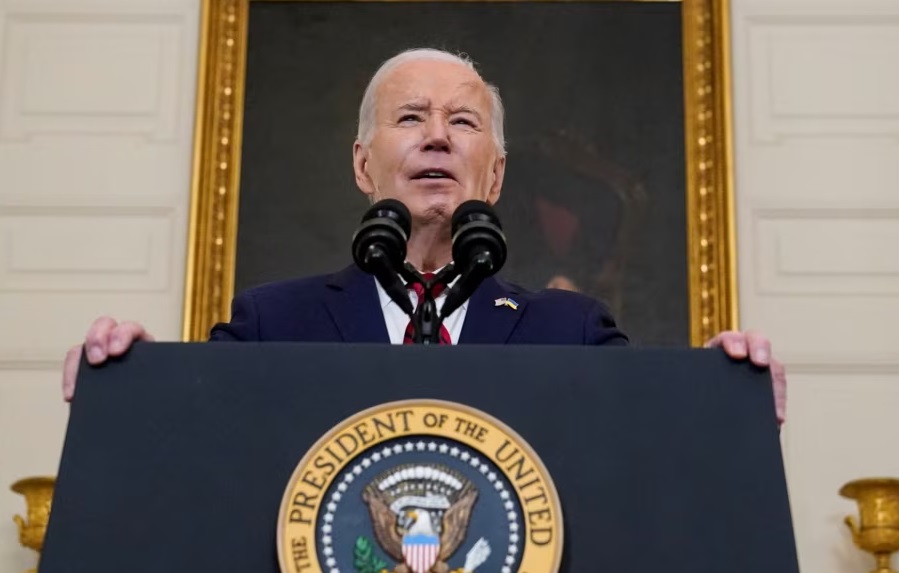
Fellow, Center for International Security and Strategy, Tsinghua University

Research Assistant, Ankara Center for Crisis and Policy Studies

President Biden announces the signing of a $95 billion military assistance package for Ukraine, Israel and Taiwan.
On April 20, the U.S. House of Representatives passed a $95 billion bill that included provisions for security assistance to Ukraine, Israel and Taiwan. The bill also attended to GOP legislative priorities, encompassing sanctions targeting Iran and a potential ban of TikTok. It allocates $61 billion to Ukraine, $26 billion to Israel, and $8 billion for Indo-Pacific regional security. The Senate then overwhelmingly passed the measure in a 79-18 vote three days later, and President Joe Biden subsequently signed it into law.
It is useful to examine the impact of the new bill on Ukraine’s struggle, the factors driving bipartisan compromise on the legislation despite traditional Republican opposition and the implications of the upcoming U.S. presidential election in November on the future of foreign aid to Ukraine and overall transatlantic relations.
Since last year, Biden has been urging Congress to approve additional aid to Ukraine. However, Republican opposition has focused on national border security and the country’s increasing debt burden. This has led to a prolonged refusal by House Republicans to provide aid to Ukraine unless Biden implements strict immigration measures at the U.S.-Mexico border. Eventually, the Senate passed a $95 billion emergency aid package without any immigration measures, thereby intensifying pressure on the House to pass the bill.
The House this time voted 311-112 for Ukraine aid, 366-58 for Israel aid, 385-34 for Indo-Pacific security and 360-58 for the TikTok and Iran sanctions measures. In the vote regarding funding for Ukraine, 112 Republicans opposed the bill while 101 supported it, indicating that aid to Ukraine was the most contentious issue, having unanimous support from Democrats but dividing Republicans.
The congressional package bears resemblance to the bill passed by the Senate in February; however, to appease resistant far-right members within his own GOP conference, House Speaker Mike Johnson divided the bill into four parts, allowing members to vote according to their conscience. In addition to voting on three separate bills concerning foreign aid, the package includes new amendments aimed at garnering conservative support, such as sanctions on Iran, granting the executive branch authority to seize and transfer frozen Russian assets held in the United States to Ukraine and introducing measures that could potentially lead to a nationwide ban on TikTok.
Faced with intense opposition from Republicans regarding aid to Ukraine, Johnson structured the bill in this manner to capture different support coalitions without allowing opposition to any one element to derail the entire effort. These adjustments paved the way for approval of the bill.
Republican Oklahoma Senator Markwayne Mullin, who opposed the aid bill approved by the Senate in February, announced his support for the bill this time, saying that 75 percent of the funds remain within the U.S. and will be used to replenish munitions for the U.S. military. Approximately $23 billion of the total $61 billion for Ukraine will be used by the United States to replenish its stocks, potentially opening the door for future U.S. military transfers to Ukraine.
The Pentagon and congressional representatives hope that the additional funds injected into the U.S. industrial base will help expand munitions production lines nationwide. While more than $11 billion of the money will be used to finance ongoing U.S. military operations in the region, approximately $14 billion included in the bill will assist Ukraine in purchasing advanced weapons systems and other defense equipment.
Although passage through Congress removes the biggest obstacle to President Biden’s funding request made in October, when Ukraine’s military supplies began to dwindle, the delay has raised widespread questions about America’s commitment to its allies worldwide. Burden-sharing, a long-standing theme of U.S. policy with its NATO partners — aiming for allies to spend 2 percent of their GDP on defense — has been a continuing issue. Faced with delayed U.S. assistance, Europeans have wondered whether Ukraine and Europe can rely on America’s commitment to them.
While the European Union and individual European countries have provided significant additional military and financial aid to Ukraine, the absence of additional assistance from the United States has been felt sharply on the Ukrainian front. Over the past seven months, Ukraine has largely lost ground in its military campaign because of delays in supplies coming from its allies.
Now, the bipartisan passage of the foreign aid bill by the U.S. sends a message to Europe that America remains a reliable partner. These signals are significant not only for the future of Ukraine but also for Europe, where concerns are high about what Russia might do next.
While the predictability of funding contributes to shaping Ukraine’s defense strategies this year, there will be a need for more planning and financing for 2025. If the $61 billion allocation is not routinely renewed, this assistance will only provide short-term support for Ukraine’s war efforts. The long-term impact of any additional support will depend on its predictability.
In this context, future challenges in Ukrainian policy are likely to be greatly influenced by the U.S. election cycle. Depending on who is elected president, securing further U.S. support may become increasingly difficult. Indeed, much of the opposition to security assistance in both the House of Representatives and the Senate has come from Republicans with close ties or loyalty to former President Donald Trump, who emphasizes “America first” policies.
The NATO Washington Summit scheduled for July may also shape discussions on what the alliance is willing to do for Ukraine. America’s allies are poised to show they’re serious about burden-sharing, particularly NATO’s 2 percent benchmark. Nevertheless, they will also scrutinize the strength of the U.S. commitment to burden-sharing for Europe’s defense, given the complexities involved in financing Ukraine’s existential struggle.
However, for Europe the biggest concern for Europe remains the prospect of Trump’s re-election. Even out of office, Trump has demonstrated his influence over the Republican Party, which does not bode well for continued U.S. support of Ukraine or stable transatlantic relations.
If Trump were to be re-elected — and indeed capable of quickly resolving the Russia-Ukraine conflict, as he claims — the most likely approach would involve striking some kind of grand bargain with Russia. Europe is concerned that such a geopolitical transaction could come at the expense of both Ukraine and European interests. While a Trump plan might achieve temporary peace, it will not likely address the broader challenges facing Europe’s security architecture.
